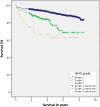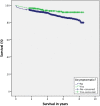Neurosurgical treatment and outcome patterns of meningioma in Sweden: a nationwide registry-based study
- PMID: 30675656
- PMCID: PMC6373228
- DOI: 10.1007/s00701-019-03799-3
Neurosurgical treatment and outcome patterns of meningioma in Sweden: a nationwide registry-based study
Abstract
Background: Surgery is the main treatment modality for intracranial meningiomas, but data on short-term surgical outcome are limited. The aim of this Swedish nationwide registry-based study was to benchmark the 30-day complication rate in a cohort of meningioma patients using data from the Swedish brain tumor registry (SBTR). Furthermore, we investigated outcomes for asymptomatic patients.
Methods: Data were collected from the SBTR for all adults with histopathologically verified intracranial meningioma between 2009 and 2015. Patient symptoms, tumor characteristics, and complications within 30 days postoperatively were analyzed.
Results: In total, 2324 patients, with a mean age of 58.7 years (SD 13.5), underwent surgery for intracranial meningioma and 14.1% of the patients were asymptomatic before the intervention. The most common symptom prior to treatment was focal deficit, which occurred in 1450 patients (62.4%). Moreover, within 30 days after surgery, 344 patients (14.8%) developed new neurological deficits and new-onset seizures occurred in 105 patients (4.5%), while 8.3% of asymptomatic patients developed neurological deficit and 3.7% new-onset seizures. Due to complications, reoperations were performed in 120 patients (5.2%). The postoperative 30-day mortality in the whole cohort was 1.5%.
Conclusion: This study benchmarks the 30-day complication rate after meningioma surgery and provides outcome data in the highly relevant group of asymptomatic patients using data from the Swedish brain tumor registry. Since surgical decision-making is a careful consideration of short-term risk versus long-term benefit, this information may be useful for both caregivers and patients.
Keywords: Health registry; Meningioma; Neurosurgery; Population-based.
Conflict of interest statement
Conflict of interest
All authors certify that they have no affiliations with or involvement in any organization or entity with any financial interest (such as honoraria; educational grants; participation in speakers’ bureaus; membership, employment, consultancies, stock ownership, or other equity interest; and expert testimony or patent-licensing arrangements), or non-financial interest (such as personal or professional relationships, affiliations, knowledge, or beliefs) in the subject matter or materials discussed in this manuscript.
Ethical approval
This project was approved by the regional ethical committee in Western Sweden (DNR 363-17) and by the registry holder. This article does not contain any studies with human participants performed by any of the authors.
Figures
References
-
- Aizer AA, Bi WL, Kandola MS, Lee EQ, Nayak L, Rinne ML, Norden AD, Beroukhim R, Reardon DA, Wen PY, Al-Mefty O, Arvold ND, Dunn IF, Alexander BM. Extent of resection and overall survival for patients with atypical and malignant meningioma. Cancer. 2015;121:4376–4381. doi: 10.1002/cncr.29639. - DOI - PubMed
-
- Al-Shahi Salman R, White PM, Counsell CE, du Plessis J, van Beijnum J, Josephson CB, Wilkinson T, Wedderburn CJ, Chandy Z, St George EJ, Sellar RJ, Warlow CP. Outcome after conservative management or intervention for unruptured brain arteriovenous malformations. Jama. 2014;311:1661–1669. doi: 10.1001/jama.2014.3200. - DOI - PubMed
Publication types
MeSH terms
Grants and funding
LinkOut - more resources
Full Text Sources
Medical



